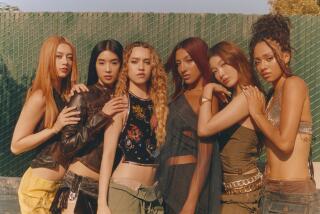POP MUSIC : The Deee-Lites of Dance Scene : A Russian, a Japanese and a Pittsburgh singer deliver a rampant party message
- Share via
As photo shoots go, this one is a winner.
The hairstylist is coaxing a helmet of red hair to cosmic proportions. The makeup artist, who grew up on reruns of “Bewitched,” is perfecting a hypermascaraed, neo-Endora look and, with every other stroke, observes, “Genius . . . genius! “
Meanwhile, the up-and-coming pop star they’re working on--a singer in silver platform mules who has just called her banana-yellow, micro-mini Gianni Versace dress “too conservative from the front”--is belting out a song. And she’s noticed in a mirror that her nose is shiny.
“I’ve got to powder,” blasts Lady Miss Kier--to the tune of Snap’s nightclub anthem “I’ve Got the Power.”
An insider’s joke? Yes. But for Deee-Lite, it’s an insider’s world.
Launched from the velvet-roped Manhattan nightclub scene, where no one bats a false eyelash at muscle men dancing with drag queens in bouffants and baby-doll dresses, the self-described “holographic techno-soul” group Deee-Lite has emerged as one of the dance music acts of the moment.
The multinational trio unites Russian emigre Super DJ Dmitry and Japanese computerized music whiz Jungle DJ Towa Towa with a singing fashion plate from Pittsburgh named Lady Miss Kier. Dmitry met Kier Kirby in New York’s Washington Square Park, and they in turn met Towa at a downtown club where Dmitry was spinning records. Dmitry was impressed with a tape from Towa Towa’s sampled music; they decided to combine it with the straight-ahead funk he and Kier had been making, and a signature sound was born.
Together they’re making their mark with a video-genic mix of supremely danceable rhythms, catchy lyrics and rampant party enthusiasm. By most accounts, the combination works.
The 12 tracks of their debut recording, “World Clique,” mix happy rap, house music, funk and sampled sound bites. “We wanted to make the ultimate party album,” says Towa. And nightclub dance floors full of kids the world over would say they succeeded.
Both the album and the first single, “Groove Is in the Heart,” were well received. Even the critics liked it. Jon Pareles of the New York Times, for instance, called it “the best of the new crop of house albums.”
“Groove Is in the Heart” shows the group’s flair for giddy pop. It begins with a sampled voice saying, “Now we’re going to dance and have some fun,” which is something of a Deee-Lite credo. Disco devotees picked up on the beat. A guest appearance in the recording by “urban poet” Q-Tip, from the rap group A Tribe Called Quest, nudged the single onto the turntables of serious hip-hop enthusiasts.
Sampling gave it the buoyancy of arty pop. “Sampling to me is very psychedelic,” says Kier. “It’s time-tripping. It’s taking a special moment from the past and mixing it with a special moment from the present to make the sound of the future.”
Or, at least, the sound of the present. Four months ago, the British style monthly the Face declared Deee-Lite the band of the year. Other awards, especially from the dance music press, have been plentiful.
“Dance music was in a doldrums period,” says Stephanie Shepherd, managing editor of the music industry trade publication DMR (Dance Music Report). “Deee-Lite was just a bright enthusiastic kind of band that popped up, right off the streets of New York, right from the underground scene. They’re colorful and vibrant in a world of mediocre talent.”
Still, the strength of Deee-Lite’s retro-futuristic look, evident in their videos and album graphics, hasn’t hurt their success. “People like the image thing, the candy coating,” Dmitry admits. In outrageous ‘60s and ‘70s clothes--moon suits, cat suits--Deee-Lite appears as living cartoon characters, heirs apparent to H. R. Pufnstuf with a dash of Superfly thrown in for sex appeal.
On the jacket of the latest 12-inch single, “E.S.P.,” backed with “Good Beat,” the trio’s heads pop out of dime-store plastic roses in a photograph by trendy French photo artists Pierre et Gilles. The flip side is a drawing of a poodle-haired beauty and a Cheshire-esque cat by the downtown Manhattan artist/performer Tabboo! He’s an old friend from Wigstock, the annual drag festival in New York’s East Village where Deee-Lite has often performed. Tabboo! (a.k.a. Stephen Tashjian) created the lettering for all of Deee-Lite’s recordings.
The fringe New York fashion/art community from which Deee-Lite sprang remains true to the group and vice versa. “Everybody I know talks about them as much as they do Madonna,” says David Yarritu, downtown New York fashion stylist.
Says Kier: “Whatever we give to the crowd at Wigstock, we get back like tenfold. It’s the same with the audience everywhere we’ve played. There’s nothing else like seeing people in all countries reacting the same way to our shows.
“Someone told us once, ‘Oh, when you get to Germany, they’re going to be real stiff, they’re not going to dance, they’re not going to scream.’ We went there and it wasn’t true at all. They were reacting the same way the kids in Miami were, yelling and smiling.”
Welcome to the World Clique.
Among those on the Deee-Lite bandwagon were more established fashion types. “What Is Love?,” the B side of “Groove Is in the Heart,” was the fashion-show runway song in Paris and Milan during the ready-to-wear collection premieres last October. Over and over, the recorded voice of Kier was heard asking the musical question, “How do you say deee-gorgeous?”
Italian Vogue devoted a five-page spread to the group. Last month, French designer Thierry Mugler used Kier and Dmitry as runway models for a show. (The season before, he used Diana Ross.) “It was a dream come true for us,” Kier says.
Although Deee-Lite has found success on the dance music charts, the “Groove” single remains its only crossover hit, reaching No. 4 on the pop music charts.
They could use another hit away from the clubs. “We’re in the process of establishing the band as more than just ‘one hit record,’ ” says Deee-Lite co-manager Bill Coleman, a former dance-music columnist for Billboard magazine. “With these next couple of singles that we release, we’ll find out if we’re able to do that.”
Deee-Lite’s newest single, remixes of “E.S.P.” and “Goodbeat,” includes a non-album track called “Riding on Through.” These tracks are already popular with nightclub deejays. “Our whole priority is to the clubs and to our peers, who are people who go to clubs and that whole club scene,” admits Coleman. “For us, radio success obviously is going to help spread the word to the Midwest, but the most important thing is to put out good 12-inches (records) and good singles and make sure that the mixes are state of the dance floor.”
Live performances should help spread the word, too. Deee-Lite has just launched its first all-live tour with an eight-piece backup band, an ambitious undertaking for a group used to performing with taped accompaniment in tiny East Village rooms and small clubs in other cities. The group performed with an 11-piece band at the huge Rock in Rio festival earlier this year, and they headline the Hollywood Palladium tonight and Iguanas in Tijuana on Tuesday.
The move toward being a full-fledged live act is necessary if the band is to be more than a record-making entity. “Traditionally dance (music) acts have gone on the road without a band and done quite well,” says DMR’s Shepherd. “But there is a trend today toward people wanting real instead of simulated. They want proof that (the artists) can really sing.”
It helps that Deee-Lite has the backing of a major label, Elektra. But it wasn’t always sure it would get it. Often, with dance music, labels will buy the rights to individual songs rather than sign artists to record deals. But Elektra is pushing the band, not just a few songs.
“Record companies are just starting to realize what’s going on with dance music,” Towa says. “These days some of the major labels are picking up really good (artists), which never happened before. Four years ago, I met (artists and repertoire) people from major labels and I wasn’t interested in what they offered me. It was always sellout stuff.”
Adds Kier: “We believed that a major label could work, even though all odds were against it. We kind of believed in destiny. We met each other. So that gave us the strength to believe that we could find someone in the business world that would understand respect us.”
The downside of their newfound success is that it has left little time for the band members to jam or see friends. Kier, who lives with Dmitry in the East Village, says they finally have enough money to move into an apartment bigger than their tiny St. Mark’s Place digs, but they’ve no time to look for a new place. “I’ve never been as busy as I am now. I haven’t had very much time to do music,” says Dmitry. “But other than that I’m having a ball.”
More to Read
The biggest entertainment stories
Get our big stories about Hollywood, film, television, music, arts, culture and more right in your inbox as soon as they publish.
You may occasionally receive promotional content from the Los Angeles Times.










